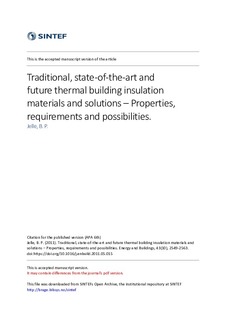| dc.contributor.author | Jelle, Bjørn Petter | |
| dc.date.accessioned | 2017-12-23T21:41:23Z | |
| dc.date.available | 2017-12-23T21:41:23Z | |
| dc.date.created | 2011-08-30T19:59:52Z | |
| dc.date.issued | 2011 | |
| dc.identifier.citation | Energy and Buildings. 2011, 43 (10), 2549-2563. | nb_NO |
| dc.identifier.issn | 0378-7788 | |
| dc.identifier.uri | http://hdl.handle.net/11250/2473737 | |
| dc.description.abstract | The advantages and disadvantages of the thermal building insulation materials and solutions have been treated. Both traditional, state-of-the-art and possible materials and solutions beyond these have been investigated. Examples of these may be mineral wool, expanded polystyrene, extruded polystyrene, polyurethane, vacuum insulation panels, gas insulation panels, aerogels, and future possibilities like vacuum insulation materials, nano insulation materials and dynamic insulation materials. Various properties, requirements and possibilities have been compared and studied. Among these are thermal conductivity, perforation vulnerability, building site adaptability and cuttability, mechanical strength, fire protection, fume emission during fire, robustness, climate ageing durability, resistance towards freezing/thawing cycles, water resistance, costs and environmental impact. Currently, there exist no single insulation material or solution capable of fulfilling all the requirements with respect to the most crucial properties. That is, for the buildings of today and the near future, several insulation materials and solutions are used and will have to be used depending on the exact circumstances and specifications. As of today, new materials and solutions like e.g. vacuum insulation panels are emerging, but only slowly introduced in the building sector partly due to their short track record. Therefore it will be of major importance to know the limitations and possibilities of all the insulation materials and solutions, i.e. their advantages and disadvantages. In this respect new conceptual thermal building insulation materials are also discussed. | nb_NO |
| dc.description.sponsorship | Acknowledgements. This work has been supported by the Research Council of Norway and several partners through the SINTEF and NTNU research projects “Robust Envelope Construction Details for Buildings of the 21st Century” (ROBUST), the “Concrete Innovation Centre” (COIN) and “The Research Centre on Zero Emission Buildings” (ZEB) | nb_NO |
| dc.language.iso | eng | nb_NO |
| dc.publisher | Elsevier | nb_NO |
| dc.rights | Attribution-NonCommercial-NoDerivatives 4.0 Internasjonal | * |
| dc.rights.uri | http://creativecommons.org/licenses/by-nc-nd/4.0/deed.no | * |
| dc.subject | Traditional | nb_NO |
| dc.subject | State-of-the-art | nb_NO |
| dc.subject | Future | nb_NO |
| dc.subject | Thermal insulation | nb_NO |
| dc.subject | Building insulation | nb_NO |
| dc.subject | Properties | nb_NO |
| dc.subject | Requirements | nb_NO |
| dc.subject | Possibilities | nb_NO |
| dc.subject | Thermal performance | nb_NO |
| dc.subject | Robustness | nb_NO |
| dc.subject | Buildings | nb_NO |
| dc.subject | Environmental impact | nb_NO |
| dc.subject | Fire protection | nb_NO |
| dc.subject | Fire resistance | nb_NO |
| dc.title | Traditional, State-of-the-Art and Future Thermal Building Insulation Materials and Solutions – Properties, Requirements and Possibilities | nb_NO |
| dc.type | Journal article | nb_NO |
| dc.type | Peer reviewed | nb_NO |
| dc.description.version | acceptedVersion | nb_NO |
| dc.rights.holder | © 2017 Elsevier B.V. All rights reserved. This is the authors' accepted and refereed manuscript to the article, post-print. Released with a Creative Commons Attribution Non-Commercial No Derivatives License. The final publication is available at https://doi.org/10.1016/j.enbuild.2011.05.015 | nb_NO |
| dc.subject.nsi | VDP::Technology: 500 | nb_NO |
| dc.source.pagenumber | 2549-2563 | nb_NO |
| dc.source.volume | 43 | nb_NO |
| dc.source.journal | Energy and Buildings | nb_NO |
| dc.source.issue | 10 | nb_NO |
| dc.identifier.doi | 10.1016/j.enbuild.2011.05.015 | |
| dc.identifier.cristin | 835769 | |
| cristin.unitcode | 7401,30,40,0 | |
| cristin.unitname | Arkitektur, byggematerialer og konstruksjoner | |
| cristin.ispublished | true | |
| cristin.fulltext | original | |
| cristin.fulltext | postprint | |
| cristin.qualitycode | 2 | |

